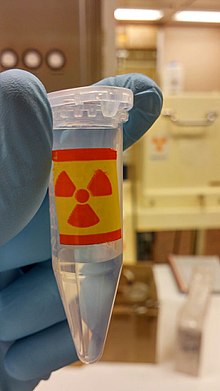Radiopharmaceutical
A radiopharmaceutical (also called a radiopharmaceutical ) is a medicine used in nuclear medicine . It can consist of a radioactive substance alone or of a carrier to which the radioactive substance is coupled. Radiopharmaceuticals are used in particular for diagnostics ( radiodiagnostics ) in scintigraphy , positron emission tomography (PET) and single photon emission computed tomography (SPECT) , the difference being that compared to other methods, such as X-rays , for example no steady states are represented here, but metabolic processes . In addition, radiopharmaceuticals can be used to treat illnesses or physical conditions ( radiotherapeutic agents).
The radiopharmaceutical is engaged in the development and manufacture of radiopharmaceuticals.
application
Both its pharmacological properties ( pharmacodynamics , pharmacokinetics ) and the radiochemical properties of the nuclide (type of radiation , activity , half-life ) determine the use of a radiopharmaceutical. For example, radionuclides , which primarily emit beta radiation, are used for therapy because they only emit intense radiation over short distances and their radioactive effect therefore remains in the body. Positron emitters (beta emitters) in PET are an exception. When they decay, they produce annihilation radiation (two coincident gamma quanta with 511 keV ), which are registered by the PET scanner. Gamma emitters, on the other hand, whose rays travel over a longer distance but are less intense, are mainly used for diagnostics and are recorded using a gamma camera . Gamma emitters are also used as radiation sources in radiation therapy (e.g. for afterloading ).
Substances
Ibritumomab-Tiuxetan is an example of a radiopharmaceutical .
